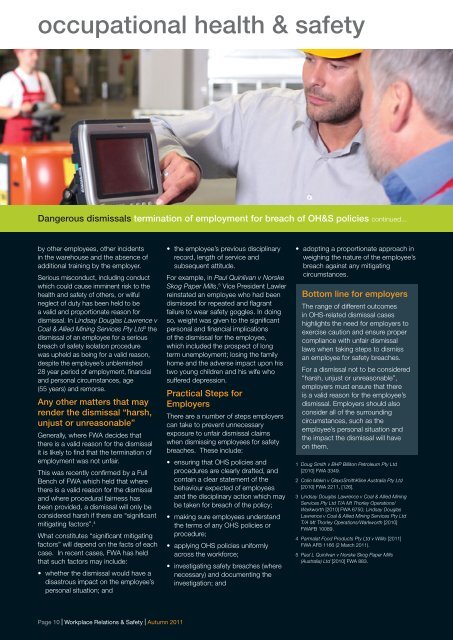Autumn Bulletin
Autumn Bulletin
Autumn Bulletin
Create successful ePaper yourself
Turn your PDF publications into a flip-book with our unique Google optimized e-Paper software.
occupational health & safety<br />
Dangerous dismissals termination of employment for breach of OH&S policies continued...<br />
by other employees, other incidents<br />
in the warehouse and the absence of<br />
additional training by the employer.<br />
Serious misconduct, including conduct<br />
which could cause imminent risk to the<br />
health and safety of others, or wilful<br />
neglect of duty has been held to be<br />
a valid and proportionate reason for<br />
dismissal. In Lindsay Douglas Lawrence v<br />
Coal & Allied Mining Services Pty Ltd 3 the<br />
dismissal of an employee for a serious<br />
breach of safety isolation procedure<br />
was upheld as being for a valid reason,<br />
despite the employee’s unblemished<br />
28 year period of employment, financial<br />
and personal circumstances, age<br />
(55 years) and remorse.<br />
Any other matters that may<br />
render the dismissal “harsh,<br />
unjust or unreasonable”<br />
generally, where FWA decides that<br />
there is a valid reason for the dismissal<br />
it is likely to find that the termination of<br />
employment was not unfair.<br />
This was recently confirmed by a Full<br />
Bench of FWA which held that where<br />
there is a valid reason for the dismissal<br />
and where procedural fairness has<br />
been provided, a dismissal will only be<br />
considered harsh if there are “significant<br />
mitigating factors”. 4<br />
What constitutes “significant mitigating<br />
factors” will depend on the facts of each<br />
case. In recent cases, FWA has held<br />
that such factors may include:<br />
• whether the dismissal would have a<br />
disastrous impact on the employee’s<br />
personal situation; and<br />
Page 10 l Workplace Relations & Safety l <strong>Autumn</strong> 2011<br />
• the employee’s previous disciplinary<br />
record, length of service and<br />
subsequent attitude.<br />
For example, in Paul Quinlivan v Norske<br />
Skog Paper Mills, 5 Vice President Lawler<br />
reinstated an employee who had been<br />
dismissed for repeated and flagrant<br />
failure to wear safety goggles. In doing<br />
so, weight was given to the significant<br />
personal and financial implications<br />
of the dismissal for the employee,<br />
which included the prospect of long<br />
term unemployment; losing the family<br />
home and the adverse impact upon his<br />
two young children and his wife who<br />
suffered depression.<br />
practical Steps for<br />
employers<br />
There are a number of steps employers<br />
can take to prevent unnecessary<br />
exposure to unfair dismissal claims<br />
when dismissing employees for safety<br />
breaches. These include:<br />
• ensuring that OHS policies and<br />
procedures are clearly drafted, and<br />
contain a clear statement of the<br />
behaviour expected of employees<br />
and the disciplinary action which may<br />
be taken for breach of the policy;<br />
• making sure employees understand<br />
the terms of any OHS policies or<br />
procedure;<br />
• applying OHS policies uniformly<br />
across the workforce;<br />
• investigating safety breaches (where<br />
necessary) and documenting the<br />
investigation; and<br />
• adopting a proportionate approach in<br />
weighing the nature of the employee’s<br />
breach against any mitigating<br />
circumstances.<br />
Bottom line for employers<br />
The range of different outcomes<br />
in OHS-related dismissal cases<br />
highlights the need for employers to<br />
exercise caution and ensure proper<br />
compliance with unfair dismissal<br />
laws when taking steps to dismiss<br />
an employee for safety breaches.<br />
For a dismissal not to be considered<br />
“harsh, unjust or unreasonable”,<br />
employers must ensure that there<br />
is a valid reason for the employee’s<br />
dismissal. employers should also<br />
consider all of the surrounding<br />
circumstances, such as the<br />
employee’s personal situation and<br />
the impact the dismissal will have<br />
on them.<br />
1 Doug Smith v BHP Billiton Petroleum Pty Ltd<br />
[2010] FWA 3349.<br />
2 Colin Makin v GlaxoSmithKline Australia Pty Ltd<br />
[2010] FWA 2211, [126].<br />
3 Lindsay Douglas Lawrence v Coal & Allied Mining<br />
Services Pty Ltd T/A Mt Thorley Operations/<br />
Warkworth [2010] FWA 6750; Lindsay Douglas<br />
Lawrence v Coal & Allied Mining Services Pty Ltd<br />
T/A Mt Thorley Operations/Warkworth [2010]<br />
FWAFB 10089.<br />
4 Parmalat Food Products Pty Ltd v Wililo [2011]<br />
FWA AFB 1166 (2 March 2011).<br />
5 Paul L Quinlivan v Norske Skog Paper Mills<br />
(Australia) Ltd [2010] FWA 883.


